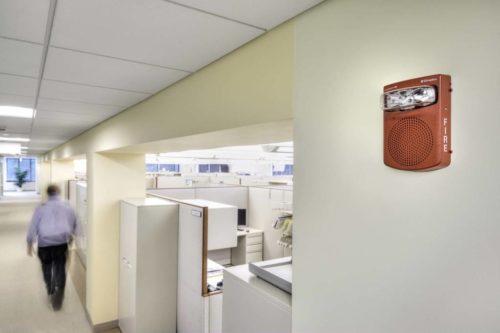
Photos courtesy Johnson Controls
By Bill Maginas
While addressable technology has been employed for many years on the ‘detection’ side of fire alarm systems, it can now also be used on the ‘notification’ side. This combination offers a multitude of benefits that can be realized at every stage in the life cycle, from design and installation to operation and ongoing service.
Specifically, addressable notification technology helps improve power efficiency and reduces the cost of installation, maintenance, and ownership through enhancements in system design and testing that make the process easier, more convenient, and less disruptive. Additionally, addressable technology can simplify troubleshooting by pinpointing the location of failed devices. It can make retrofits and system expansions easier and more cost-efficient by accommodating more devices per circuit and allowing tee-tapped wiring schemes.
From the standpoint of preparedness and emergency response, addressable notification enables fire alarm systems to broadcast tones and messages (audio being the most effective form of notification) to a zone or even an individual speaker. This ability to deliver messages to specific areas helps enhance emergency notification and response—this type of granularity cannot be accomplished with conventional notification circuits.
In designing new systems and updating older ones, engineers can consider and implement the following benefits of addressable notification technology to help improve the installation, performance, and overall value of life safety systems.
Advancing system design and installation
Due to its mode of operation, being addressable can significantly simplify system installations. Addressable systems leverage ‘smart’ technology that differentiates them from conventional fire alarm systems. Traditional notification has its place in certain applications, but the ‘series-parallel’ wiring scheme is mandatory. These limitations can make conventional systems more difficult to install and configure.
Addressable systems, by contrast, can be easier and less costly to install, operate, and service. In an addressable system, each device has its own unique address and is enabled for two-way communication with the fire alarm panel, which electronically supervises them 24/7. When coupled with two-way panel-to-device communication, addressability allows for sophisticated fire alarm operations. In these systems, the supervision of the circuit is not based on supervision of just the wire, which would typically rely on an end-of-line resistor connected to the in-and-out wiring to and from each device on the circuit. Rather, the supervision on an addressable circuit is based on continuous communication to each device—directly from the fire panel, regardless of the wiring path.
From an installation perspective, addressable systems can offer considerable value by reducing installation time and cost by 30 per cent or more.
Flexible wiring architecture
The wiring architecture of an addressable system is very flexible, so these circuits allow for more-efficient wiring paths, while smart devices make it easier to locate and correct wiring mistakes. At the same time, due to a slightly higher operating voltage, circuit wiring distances can be increased while circuits are able to support a larger number of appliances. This higher voltage, combined with the flexibility of the wiring scheme, means fewer power supplies, batteries, and dedicated alternating-current (AC) lines are needed to satisfy the same requirements as would be needed by a conventional notification system.
Software-based operation
An addressable system’s operation is determined by programming. Therefore, it is independent of the circuit wiring. This provides a distinct advantage over a conventional system, which must rely on circuit layout to serve a defined area.
Use of smaller gauge wire and tee-tapping
In many cases, more efficient use of power means devices can be installed with thinner, unshielded wiring that is easier to install. This can help reduce material and labour costs per job. Further, addressable technology allows for tee-tap wiring, which enables contractors to save ‘return runs’ of wire while making it easier to add new devices to an existing system. As addressable systems do not have to be wired on a loop, new devices can be wired to a nearby junction box rather than having to be spliced into a circuit or wired back to the main panel.
Setting of candela levels from the panel
The ability to set notification appliance candela levels from the fire alarm panel also helps reduce installation time because it is much more efficient than having to change jumper settings to modify the candela levels. For convenient reference of the entire system, a report showing each device and its candela setting can be generated for the building owner or authority having jurisdiction (AHJ).

Making testing, maintenance, and code compliance more efficient
Addressable notification can deliver significant benefits for building owners, facility managers, and installing contractors. Such devices offer appliance self-testing capability, as well as advanced programming and reporting features. This can accelerate and simplify the process of testing notification appliances. Tasks that used to take hours or even days can now be done quickly and efficiently, with virtually no disruption to building operations.
Taking just seconds to complete, the self-test process can be initiated manually or programmed via the fire-alarm control panel to run automatically at a convenient time, eliminating the increased costs associated with after-hours testing. Self-testing can help reduce business disruption and provide significant time and cost savings, particularly in large buildings where notification appliance testing is difficult. If a device fails the test, it will be identified at the panel, and will cause a latched trouble condition to alert the building operator service is required. After the device has been repaired—and successfully retested—the trouble condition on the panel disappears.
Simplifying retrofits and system expansions
In addition to the benefits addressable systems bring to installation, the technology also simplifies retrofit and system expansion projects. Addressable systems are easily scalable, while upgrades to new technology platforms can be completed efficiently and cost-effectively.
For example, in many cases an existing conventional system can be upgraded without the costly removal or replacement of existing field devices, wiring, conduit, or fire-alarm-panel back boxes. Typically, the existing wiring infrastructure can be reused and the time-consuming task of finding and replacing end-of-line resistors can be eliminated. This speeds project completion time and also reduces disruption for building occupants and operations teams.
Targeted audio messaging for improved emergency response
One of the latest advancements with addressable technology is the incorporation of addressable technology into fire alarm speakers. By leveraging addressability into speakers, voice-capable fire alarm systems offer individual device control. This technology provides the capability to deliver voice messages to specifically targeted areas within a building.
Each speaker has its own address on the fire alarm system and is supervised by the fire alarm panel. This means the fire alarm panel can be programmed to select which speakers are to be ‘turned on’ and what message will be broadcast by each speaker during an emergency. This targeted audio-paging capability enables the delivery of critical, event-specific information to the exact location where it is needed.
For example, in the case of a small, isolated event, an individual speaker can be activated to deliver a message solely to that specific area. In broader emergencies, groups of speakers can deliver critical evacuation instructions to specific parts of the building, based on the nature of the situation. With addressable notification systems, audio messages are dispersed as they are programmed, rather than by the wiring pattern of their circuit. This opens up a new world of flexibility, configurability, and performance for voice-enabled fire alarm systems.
Additionally, the flexibility of addressable speakers lends them to be used in a dual-purpose capacity. In an emergency, the speakers can operate as part of a building’s fire alarm system, helping notify building occupants by providing instructions to them through pre-recorded messages, tones, or live messaging. Beyond emergency messaging, the speakers can also be used for standard daily functions such as non-emergency paging.
By staying up to date and implementing new technologies like addressable notification, engineers are designing more holistic fire- and life-safety systems. At the same time, they can increase the value these systems provide to their clients, by helping building owners save time, reduce life-cycle costs, and simplify the testing, inspection, and maintenance process, both today and into the future.
 Bill Maginas is Johnson Controls’ Canada Building Solutions area vice-president and general manager, and is responsible for leading the company’s HVAC, fire protection, and security installation and service business. He was previously vice-president/GM of the Canadian Honeywell business, where he was responsible for more than 1000 employees in 24 locations across the country. Maginas holds a master’s degree in business administration from Wilfrid Laurier University (Waterloo, Ont.).
Bill Maginas is Johnson Controls’ Canada Building Solutions area vice-president and general manager, and is responsible for leading the company’s HVAC, fire protection, and security installation and service business. He was previously vice-president/GM of the Canadian Honeywell business, where he was responsible for more than 1000 employees in 24 locations across the country. Maginas holds a master’s degree in business administration from Wilfrid Laurier University (Waterloo, Ont.).




